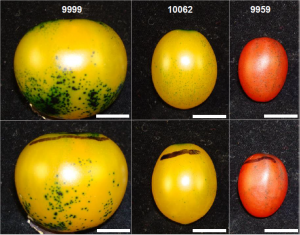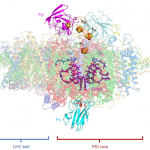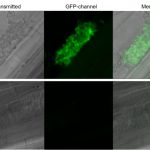Transpiration from tomato fruit occurs primarily via trichome-associated transcuticular polar pores (Plant Physiol.)
 Post harvest water loss is one of the major challenges in handling fresh agricultural products, yet its cause and mechanism are not well understood. In terrestrial plants, stomata are the primary regulators of water flux; but when the stomata are closed or in astomatous organs such as tomato fruits, the hydrophobic layer “cuticle” is the main barrier for transpiration. Using tomato cultivars with low and high fruit transpiration rates, Fich et al. show that the stem scar and cuticle contribute to the postharvest water loss in tomato fruits. As the stem scars heal by suberization a few days after the fruit harvest, the cuticle maintains the main source of transpiration. However, despite the considerable variation throughout the cultivars, neither cuticular cutin nor wax total abundance and composition explained the transpiration rate of the tomato fruits. Instead, staining by toluidine blue, they found that the hydrophilic dye enters the fruit through small hydrophilic permeable pores corresponding to the broken trichome bases. The pores that let the dye in, let the water out and their density strongly correlate with the fruits transpiration rates. Understanding this novel mechanism provides a base for agricultural practices to select cultivars with more resistance to postharvest water loss. (Summary by Roxana Khoshravesh @RoxiKh) Plant Physiol. 10.1104/pp.20.01105
Post harvest water loss is one of the major challenges in handling fresh agricultural products, yet its cause and mechanism are not well understood. In terrestrial plants, stomata are the primary regulators of water flux; but when the stomata are closed or in astomatous organs such as tomato fruits, the hydrophobic layer “cuticle” is the main barrier for transpiration. Using tomato cultivars with low and high fruit transpiration rates, Fich et al. show that the stem scar and cuticle contribute to the postharvest water loss in tomato fruits. As the stem scars heal by suberization a few days after the fruit harvest, the cuticle maintains the main source of transpiration. However, despite the considerable variation throughout the cultivars, neither cuticular cutin nor wax total abundance and composition explained the transpiration rate of the tomato fruits. Instead, staining by toluidine blue, they found that the hydrophilic dye enters the fruit through small hydrophilic permeable pores corresponding to the broken trichome bases. The pores that let the dye in, let the water out and their density strongly correlate with the fruits transpiration rates. Understanding this novel mechanism provides a base for agricultural practices to select cultivars with more resistance to postharvest water loss. (Summary by Roxana Khoshravesh @RoxiKh) Plant Physiol. 10.1104/pp.20.01105



